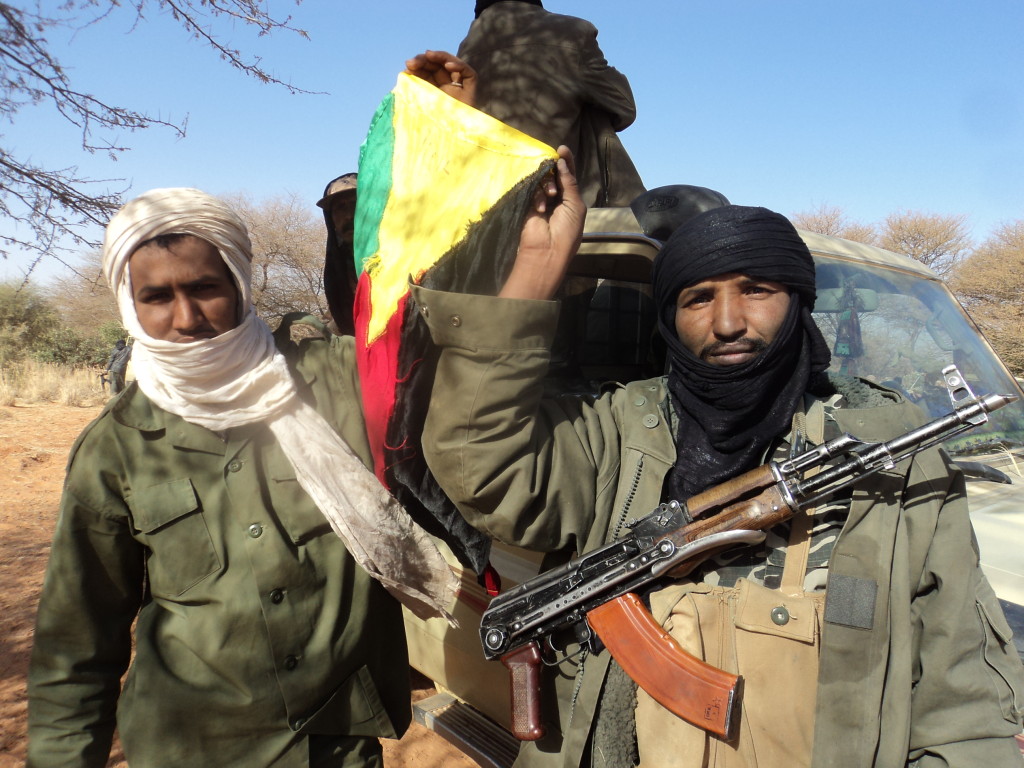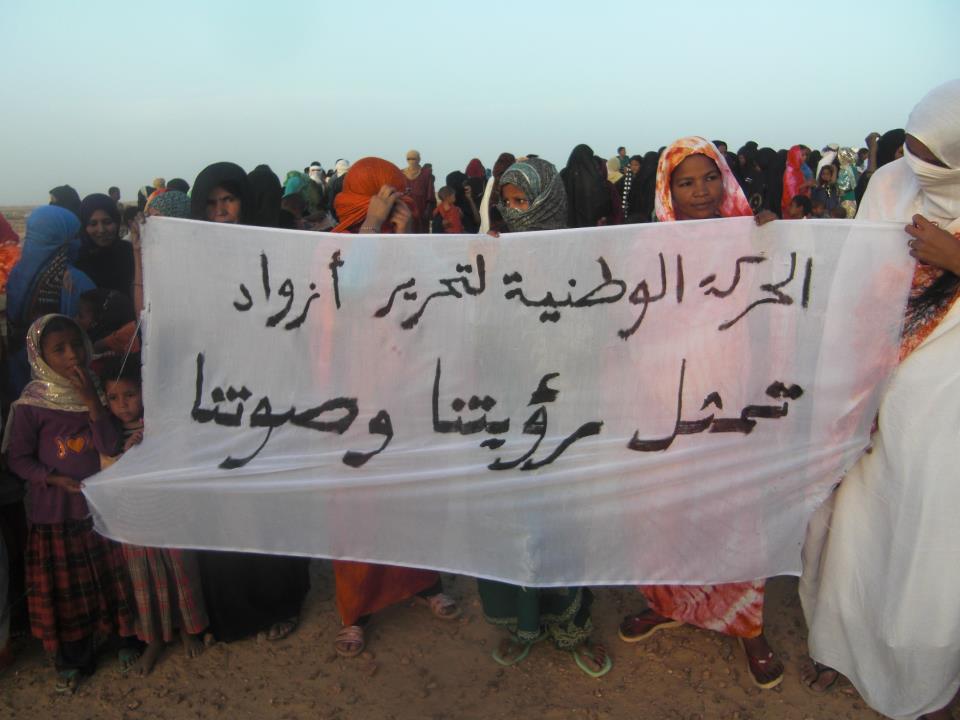Mali and the Sahel

Islamist Rebels in Mali, 2012. Picture by Magharebia | Flickr

[Originally posted here]
“You want to cut hands? Here are two! Cut them!” So dares a fishmonger to the occupiers of her hometown, theatrically presenting the officer leading them with her fileting knife. The scene is one of the most memorable from the Franco-Mauritanian Timbuktu, directed by Abderrahmane Sissako, released in December 2014.
For the film, shot in Mauritania, Sissako recreated a Malian town whose inhabitants were forced to live under Sharia law back in 2012. The scene is no mere parable—people did lose their hands and more for failing to adhere to the tenets of such “morality police” who enforced puritanism, while indulging in behaviors that they themselves judged to be “criminal.”
Mali’s ongoing internal conflict is rarely in the news today, though. The French and pan-African contingents initially deployed to the theater continue to be drawn down, though not without growing resentment in the country over how they have intervened in negotiations with the rebels, and sought basing rights that post-colonial regimes in Bamako have historically withheld. The war in Azawad, the northern half of Mali, has now denigrated into a bitter low-intensity struggle after the rebels’ blitzkrieg south stalled in 2013. Fighting continues among separatists and their central government’s allies, all of whom stand apart from the self-proclaimed “Islamic State” now rising up in Libya.
Yet from 2012 to 2013, a coalition of local Islamists allied with al-Qaeda’s wealthiest “franchisee” (AQIM) was able to seize territory and govern it. Today, that experiment has largely failed. Even before battlefield losses compelled the rebels to retreat into Niger and Algeria, their model had been greatly discredited by the indignities its architects inflicted on the region’s captive population. But with Libya’s internal conflicts drawing in more and more foreign militaries, it is worth reflecting on how a motley alliance of smugglers, international jihadists, guns-for-hire, and Malian guerillas were able to carve out a polity that quickly became an “Islamic” statelet when the rebels had a falling out within their ranks.
This development was not solely caused by NATO intervention in Libya. Nor was it necessarily a direct continuation of civil unrest in the 1990s that led to a “cold peace” in the northern half of the country. Rather, a new wave of Islamist separatism that emerged within an existing secessionist movement combined with the Libyan fallout to produce the current “low-intensity” conflict, which has cost several thousand lives and displaced over a quarter of a million Malians.
The immediate precipitant of the conflict was the fallout of the NATO-led military intervention in Libyan in 2011, which allowed Tuareg separatists to secure the hardware necessary to send motorized columns into Azawad. But the root causes of the separatist crisis dated back decades. Before 2012, the most recent such “settlement” created a “demilitarized zone” in Azawad, a poorly-policed cordon sanitare between the northern and southern halves of Mali. There was actually an increase in the presence of armed non-state actors during this, including government-backed militias and drug smugglers with friends in the general staff. Tuareg dissatisfaction—of Azawad residents’ dissatisfaction in general, irrespective of ethnicity—with the central government stemmed from heavy-handed policing by these militias (the Ganda) and poor showings by relief agencies in the face of natural disasters.
The Ganda proved to be part of the problem that helped the Islamists take Azawad so quickly, having engaged in brutal divide-and-rule tactics that weakened communities’ support for the central government across the region. Their successor groups continue to bedevil reconciliation efforts. One of the new militias that emerged from the French-assisted effort to retake Azawad was linked to officers who carried out a March 2012 coup d’état against Mali’s then-president. Another “anti-Islamist” militia, Ganda Koy, is on bad terms not just with Azawad’s Tuareg tribes, but with the regular Malian Army as well. The so-called “militiatary” track pursued by Bamako was and is a disincentive for better regulating the Ganda.
It was in this zone of lax governmental authority that al-Qaeda in the Islamic Maghreb (AQIM) moved into during the early 2000s. Its founder had been present in the region for a decade as the “Salafist Group for Preaching and Combat” (GSPC), an Algerian terrorist organization that future (now former) AQIM commander Mokhtar Belmokhtar served with. The group’s failures in Algeria drove it to advocate transnational jihadism as a substitute for real military successes, and eventually led Belmokhtar and his lieutenants to embrace al-Qaeda’s ideology during the Second Gulf War.

Before the Tuareg uprising in northern Mali, AQIM found its internationalist agenda falling on deaf ears. Yemen and Iraq were far more attractive destinations for would-be jihadists. AQIM’s marginal presence in the region changed when the non-Islamist MNLA – founded in late 2011 by Tuaregs living in Libya – took advantage of Libya’s civil war to take over Azawad. MNLA fighters, stiffened by Tuareg mercenaries formerly in Qadhafi’s service, drove into Mali and proclaimed a secular, independent state. But it took another group to actually Islamicize the revolt. This was the (also) Tuareg-led Ansar Dine, headed at the start of the conflict by Iyad ag Ghali, a former Malian diplomat and hostage negotiator. The MNLA maintained an uneasy partnership with Ansar Dine until the summer of 2012. At that juncture, the MNLA was driven out of Azawad by Ansar Dine and AQIM, which according to Serge Daniel, spun off a new entity called MUJWA to expand its regional presence among the many ethnicities of the Sahel.
By restoring some semblance of order and preaching a less-ethnocentric message, Ansar Dine and MUJWA had a bit more success than the MNLA in administering towns, but this was only relative. Setting up councils and distributing basic goods presented the appearance of ruling, but in reality hundreds of thousands of civilians fled these areas ahead of the Islamists. AQIM commanders in Algeria even warned their colleagues in Mali to stop destroying holy shrines and to make alliances of convenience with local authorities.
Desperate, the MNLA reached an understanding with the central government and returned to the field to retake Malian towns in the weeks prior to the French intervention. Since Ansar Dine had emphatically rejected autonomy for Azawad in favor of Islamization, the MNLA felt it had little choice but to side with the army it had recently driven out since they might, as a condition for the MNLA’s help, grant it some of its demands if they won (fortunately for the MNLA’s fortunes, it has found support from the French over these demands).
In the face of this turnabout, some Ansar Dine commanders defected to the MNLA while Iyad ag Ghali went into hiding. Indeed, Ansar Dine’s rank and file fighters showed themselves to be easily swayed from one camp to another by money and the promise of power. As the co-opted MNLA and defeated Ansar Dine both fade into the background, international participants in the coalition against AQIM turn back to it, and to a lesser extent MUJWA, which continues to exist as part of a larger terrorist network in the region called “Al-Mourabitoun”, now a rival of AQIM.
AQIM and “Al-Mourabitoun”/MUJWA benefit greatly from the intersection of poverty and smuggling in the Sahel. Such networks bring jihadists together with movers and shakers who can move just about anything, from cigarettes and livestock to SUVs and fuel oil across the Sahel. As a French government investigation concluded, MUJWA is “able to combine the effects of ideology and drug trafficking to recruit and indoctrinate young people.”
But actually targeting such contraband on a grand scale would require picking fights with a large, well-heeled business network that has the patronage of officials in multiple countries. If officials did want to do more about the matter, there would be a long lead-time for pursuing this course: any new effort on top of what drug interdiction work is carried out in West Africa would require a long-term commitment of resources just to better monitor the trading that goes on in the Sahel, and into North Africa and the Middle East. For example, while Algeria’s government has an interest in seeing stability return to the region, elements of the Algerian civil service and security forces are enabling criminal activities that fill jihadist coffers.
Imposing greater border controls in Algeria sounds effective, but would be opposed from many sides, and not just among corrupt officials and fencers. The emphasis on the role of illegal narcotics, in fact, may obscure the difficulties of pursuing such policies. Such moves, however well-intentioned, would in their wake probably cripple the livelihoods of migrant workers and thousands of people who are dependent on cheap Algerian exports crossing borders outside of “normal” channels.
The aforementioned limits of policing the vast region, which encompasses the borders of up to ten North and West African countries, also mean that AQIM’s cash cow, kidnapping, will not be giving bad milk anytime soon. AQIM may have “lost” their capacity to hold territory, but they have not lost their capacity to terrorize states and their populations. Such attacks can then retard legal economic activity, giving people fewer options to make a living and strengthening criminal networks – which AQIM can then offer “protection” deals to. Such an offer to “escort” a caravan is one that most merchants cannot refuse.
While the “jihadist” dimension distinguishes the fighting from previous civil wars in Mali, the conflict was in large part the continuation of those earlier battles. The “cold peace” that has followed the foreign intervention has not addressed the underlying causes of resentment in the region. Islamist opportunism, and most importantly, the continued appeal of separatism in the region to marginalized communities mean that the conflict is far from over, especially as the set piece military operations give way to counterterrorism sweeps and bitter disputes over “autonomy”.
Paul Mutter is a graduate student at NYU pursuing an MA in International Affairs. He is a blogger for the Foreign Policy Association, and also writes for War Is Boring, The Arabist and Souciant Magazine.






